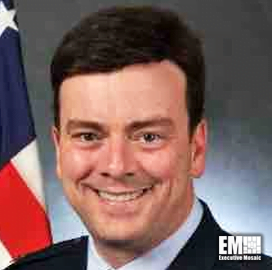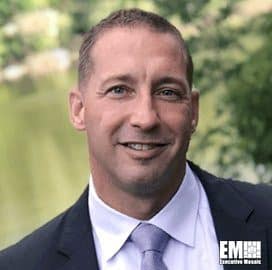
Chris Worley
VP, DOD Earth Intel,
Maxar
Member Profile: Chris Worley, VP of DOD Earth Intelligence Programs for Maxar
Chris Worley, vice president of Maxar’s Department of Defense Earth Intelligence Programs, recently spoke with the Potomac Officers Club during an exclusive Executive Spotlight interview in which he discussed his career impacts thus far, the executives who have inspired him and his thoughts on digital technology adoption. Worley’s career spans two decades and multiple senior-level roles in the private and public sectors. The POC member’s previous work includes holding directorial positions with Raytheon Technologies, serving as a U.S. Air Force commander and leading intelligence operations for the Defense Threat Reduction Agency, among his extensive work at the Pentagon.
What can you tell us about your background and how you’ve been able to adapt to the ever-changing challenges of the federal landscape over the course of your career?
“The great part about joining Maxar after a career in both the Air Force and industry is the diversity of opportunities, teams and challenges presented by the vast range of missions this company supports—from advanced Earth intelligence enabled by high-resolution satellite imagery, 3D data and AI/ML to commercial and civil spacecraft, space-based robotics and much more. I’ve spent most of my career in digital technology and intelligence applied across every phenomenology and mission. In each case, these landscapes were never static as they evolved and modernized. This taught me, through both success and failure, how to adapt, learn and apply what I gained to new challenges. My degrees are not in engineering or scientific disciplines. Rather, I studied liberal arts and languages. The emphasis on critical thinking, communication and building a bridge between technical jargon and warfighter needs is the foundation upon which I’ve built my career and the teams I’ve had the honor to work with in achieving mission goals.”
When did you decide to pursue a career in the federal landscape and what were the key tasks that you wanted to complete? Any bigger goals you still want to accomplish?
“I am passionate about service before self, which is why I joined the Air Force and decided to continue to serve from the commercial sector as a partner in developing solutions. I witnessed first-hand the challenges faced by lack of modernization and latent solutions to urgent needs. I wanted to bring this knowledge as well as my technical and leadership experience to industry, where I can continue my lifelong education and assist in crafting the solutions necessary to bolster U.S. national security.”
Who are the executives that have inspired you the most over the course of your career?
“I’ve been inspired by many executive leaders, both those I worked for and those I’ve admired from a distance. Karen Cleary was my commander when I first entered a leadership tract, and she taught me empathy, the difference between management and leadership, and the importance of vision and strategy to achieving long-term success versus short-term achievements. Lt. Gen. John “Jack” Shanahan (now retired) was always a role model and someone I trusted to be firm, fair and honest with me. He embraced new ideas, technologies and approaches. Like Teddy Roosevelt’s famed speech, “The man in the arena,” Lt. Gen. Shanahan was not guided by fear, but rather jumped in and risked failure today so we could all succeed tomorrow. I also find inspiration from leaders who chart bold technological courses. They have vision and inspire others to achieve more than they thought possible—the late Steve Jobs, Microsoft’s Satya Nadella or Tony Frazier here at Maxar. Tony’s vision, passion and willingness to engage our workforce at every level drives excellence across the company.”
If your career came to an end tomorrow, what would you say have been the most significant accomplishments of your career? Where do you feel you made the most impact?
“Often, the seeds we plant don’t bear fruit for years. I was very proud of standing up the first Innovation Laboratory in an Air Force wing when I commanded the Air Force Technical Applications Center. I am also proud of the work that team did with diversity, inclusion and belonging—crafting the first strategy for an Air Force wing, launching the Women in Science and Engineering (WISE) annual Symposium and adopting a local elementary school to champion STEM education. All of these are long plays, but I believe they will contribute to future achievement.”
What are the core values that you believe are essential to build a great team and establish a foundation to drive success in such a competitive industry?
“Core values are essential in defining the work environment, the culture and the effectiveness of the team. Putting the mission first, working collaboratively with two-way communication, fostering and rewarding curiosity and innovation, taking and sharing ownership of work, committing to excellence in execution and above all, ensuring everyone knows how important they are to the team are all essential elements of effective leadership. These are very much aligned with Maxar’s values, which made joining the company an easy decision.”
With emerging technology influencing the federal government and industry more by the day, what are some of the challenges on the business side of innovation that aren’t always discussed as often as they should be?
“We probably don’t spend enough time talking about and addressing the cultural aspects of digital technology adoption. There needs to be an understanding that we are not just fielding a product or a tool, but rather an environment for human-machine teaming. This gets to the need for explainable AI, to open discussions and to the value of engaging stakeholders early. The best technology in the world will not achieve success unless people feel comfortable using it and trust the results it yields.”

Category: Executive Profiles




